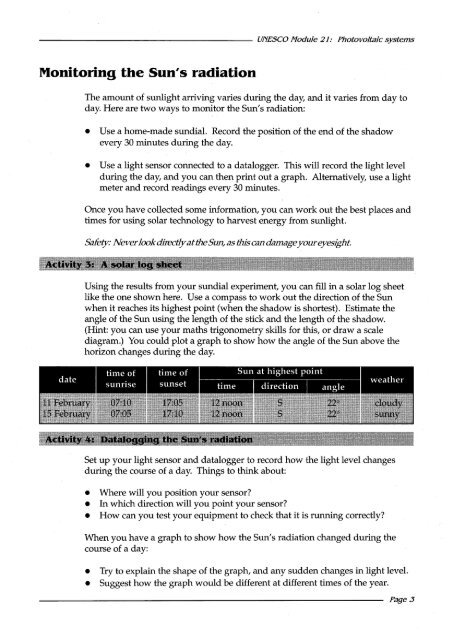UNESCO resource kit - science and technology educa...
UNESCO resource kit - science and technology educa...
UNESCO resource kit - science and technology educa...
You also want an ePaper? Increase the reach of your titles
YUMPU automatically turns print PDFs into web optimized ePapers that Google loves.
------------------------ <strong>UNESCO</strong> Module 21: Photovoltaic systems<br />
Monitoring the Sun's radiation<br />
The amount of sunlight arriving varies during the day, <strong>and</strong> it varies from day to<br />
day. Here are two ways to monitor the Sun's radiation:<br />
• Use a home-made sundial. Record the position of the end of the shadow<br />
every 30 minutes during the day.<br />
• Use a light sensor connected to a datalogger. This will record the light level<br />
during the day, <strong>and</strong> you can then print out a graph. Alternatively, use a light<br />
meter <strong>and</strong> record readings every 30 minutes.<br />
Once you have collected some information, you can work out the best places <strong>and</strong><br />
times for using solar <strong>technology</strong> to harvest energy from sunlight.<br />
Safety: Never look directly at the Sun/ as this can damage your eyesight<br />
Using the results from your sundial experiment, you can fill in a solar log sheet<br />
like the one shown here. Use a compass to work out the direction of the Sun<br />
when it reaches its highest point (when the shadow is shortest). Estimate the<br />
angle of the Sun using the length of the stick <strong>and</strong> the length of the shadow.<br />
(Hint: you can use your maths trigonometry skills for this, or draw a scale<br />
diagram.) You could plot a graph to show how the angle of the Sun above the<br />
horizon changes during the day.<br />
Set up your light sensor <strong>and</strong> datalogger to record how the light level changes<br />
during the course of a day. Things to think about:<br />
• Where will you position your sensor?<br />
• In which direction will you point your sensor?<br />
• How can you test your equipment to check that it is running correctly?<br />
When you have a graph to show how the Sun's radiation changed during the<br />
course of a day:<br />
• Try to explain the shape of the graph, <strong>and</strong> any sudden changes in light level.<br />
• Suggest how the graph would be different at different times of the year.<br />
Page 3

















